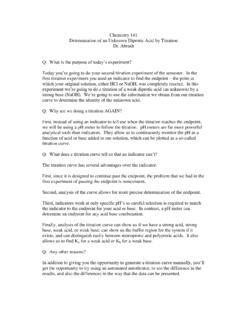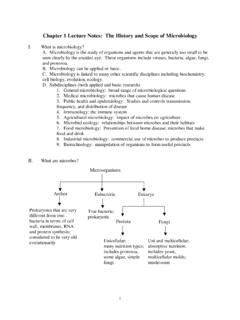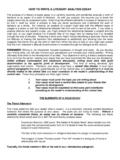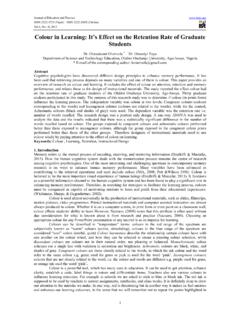Transcription of Writing a Scientific Research Paper - University of Richmond
1 Writing a Scientific Research PaperWriting ResourcesBesides the information noted in your course materials and this handout, other writingresources are available: The Mayfield Handbook of Technical and Scientific Writing and other on-lineresources are available at < >. The Writing and Communication Center < > is located in14N-317, x3-3090. IEEE website: Scientific Research Paper ComponentsScientific papers generally follow a conventional format that includes a title, an abstract,a reference (or Literature Cited) section and the components of the IMRAD structure:The IMRAD structure Introduction answers why? Methods answers when, where, how, how much? Results answers what? And Discussion answers so what? Writing ProcessSample Writing ProcessPrewriting Make notes, scribble ideas: start generating text, drawing figures,sketching out presentation ideas.
2 Ignore neatness, spelling, and sentence structure--get the ideas down. Analyze audience and purpose to focus your Start with whatever section is easiest to write . Skip around to different sections as needed. Keep Work on content first, then structure, then style. Keep focused on your main purpose: communicating, reasoning,presenting clearly. Get feedback. Circle back to prewriting as Check all data for accuracy. Review for grammatical, mechanical, and usage Print and read your report again. Often we don't see errors on-line aseasily as we do on a hard of the Scientific Research Paper Title Abstract Introduction Methods Results Discussion Works Cited AppendicesWhile all Scientific Research reports share a common organizational setup, you will findvariations within reports.
3 The common structure of the report is to ensure ease of must quickly filter the huge amount of information available in scientificpublications. A common organizational structure helps readers move quickly throughreports. In fact, often scientists do not read entire reports and rarely read them inchronological order. For example, they may skip directly to the findings and not read themethods. The discrete sections of a report also force the researcher to carefullydistinguish the various aspects of the experiment. For example, what is a result and whatis your interpretation of that finding?Title informative and specific concise understandableSee exampleToo vague:"Measuring a nerve response in a Frog"Just right: "The Effects of Ethanol on the Compound Action Potential of a FrogSciatic Nerve"Notice: The title is on a Cover Page The title is descriptive and concise (no jargon).
4 It tells the reader what effect youmeasured and on what organism All nouns are capitalized in the title The title is centered on the page Your names and date appear below the title33 AbstractThe abstract is a one paragraph (<100 words) summary of the report, including thequestion investigated, the methods used, the principal results and conclusions. offers a complete but selective summary of most significant ideas and information uses clear, precise wording (increase precision through successive revisions) accurately reflects the Paper 's organization, emphasis, and content on a very smallscaleWhy do we write abstracts? Abstracts are a quick way for readers to understand yourresearch project. Thus, readers can assess the relevance of your work to their own simplyby reading your abstract. Your intended audience should be able to understand theabstract without having to read any of the report.
5 Because the abstract is usually the firstthing that readers read, and based on that abstract, make a judgment whether to keepreading or not, the abstract is one of the most important elements of a Scientific exampleNotice: The abstract summarizes your Research in one paragraph. The abstract includes results The language is concise and introduction is a brief section (no more than 1 page usually) designed to inform thereader of the relevance of your Research and includes a short history or relevantbackground that leads to a statement of the problem that is being addressed. Introductionsusually follow a funnel style, starting broadly and then narrowing. They funnel fromsomething known, to something unknown, to the question the Paper is asking. focuses on the overall issue, problem, or question that your Research addresses.
6 Whatis the context of your study ( how does this relate to other Research )? provides sufficient context and background for the reader to understand and evaluateyour Research , including appropriate visual aids (drawings, etc.). Warning: Don't betoo long-winded here. You do not need an entire history of frog biology, for example. defines terms which your reader may not know. Remember other students are youraudience. defines abbreviations that will be used in the report. For example, "The compoundaction potential (CAP) .." In following instances, you may use "CAP" in place ofcompound action potential. develops the rationale for your work: poses questions or Research problems andoutlines your main Research focus. What was your Research question?See example44 MethodsThe Methods section chronologically describes the process you undertook to completethe Research .
7 The method is written as a process description, not as a lab manualprocedure. Be precise, complete, and concise: include only relevant information nounnecessary details, anecdotes, excuses, or confessions. details experimental procedures describes techniques for tracking functional variables (timing, temperature, humidity,etc.) and rational for tracking those variables explains analytical techniques usedSee exampleNotice: You do NOT need to repeat the frog dissection process described in the lab only need to describe your specific experiment method. You do not need to include an equipment list. The methods section is written in paragraph form. It is NOT written like a cookbookor a series of steps. It includes reasons why the team took certain measurements or chose to use certainequations.
8 It does NOT tell us what was discovered. That information should be in the Resultssection. It's broken down into subsections, if appropriate. It includes visuals that are labeled and referenced in the text. Tables and graphs arenumbered consecutively in the report (Table 1, Table 2, etc.). Tables and graphsinclude a title. Visuals are large enough to read the units. Each visual does not extend across morethan one page. Decimal quantities include a 0 before the decimal point. For example, Notice the format of mathematical expressions. Equations are spaced apart from are results? "Just the facts, mam."The Results section DESCRIBES but DOES NOT INTERPRET the major findings ofyour experiment. Present the data using graphs and tables to reveal any trends that youfound. Describe these trends to the reader.
9 The presentation of data may be eitherchronological, to correspond with the Methods, or in the order of most to leastimportance. If you make good use of your tables and graphs, the results can be presentedbriefly in several note about visuals: Often you'll find it more compelling to include two sets of resultswithin one graph. For example, if you are comparing the distance in time between peaksfor various concentrations of alcohol, include these findings in ONE graph. It's easier for55the reader to see the comparison if visually the data are together rather than acrossgraphs. Organize logically and use headers to emphasize the ordered sections. Report; don't discuss or interpret. Findings are matters of fact; interpretationfluctuates with perspective, opinion, and current knowledge. Reasoned speculationbelongs in Discussion; important facts and objective observations that areunambiguously true belong in Results.
10 Illustrate and summarize findings: organize data and emphasize trends and patternswith appropriate visuals. Integrate visuals with text: the text offers claims and general statements that thevisual details exampleNotice: There is text! The authors explain what is shown in each graph as well as interestinganomalies. Visuals don't fully explain, so don't expect your readers to "get" what youmean by providing a graph with no explanation. All figures are labeled and referenced in the text prior to the figure. There is no interpretation. The authors have added subsections to organize the data. Negative results are results and worth including in your report. Notice that the authors have probably not included all of their findings. While theResults section is supposed to objectively describe your Research results, it is actuallyslightly subjective in the choice and order of findings 's the Discussion?











